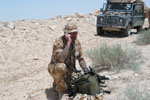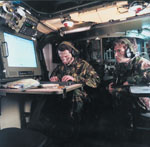Bowman Achieves Full Operational Capability
 |
| The latest software upgrade of the United Kingdom’s Bowman tactical radio system will provide commanders with enhanced situational awareness, improved battlefield management tools, and battlefield networking and Internet capabilities. |
The
Although it entered operational service in 2004 and was deployed to
But officials at the U.K. Ministry of Defence (MOD) and prime contractor General Dynamics United Kingdom indicate that the most basic Bowman capabilities are a vast improvement over the 1970s-era Clansman radios it replaces. By the end of 2008, Bowman is scheduled to replace all of the remaining Clansman radios in the British army’s inventory. Bowman is fielded across all echelons up to division headquarters.
The latest software upgrade, which includes several applications, is the Bowman, Common Battlefield Applications Toolset, Infrastructure and Platform Battlefield Information Systems Applications, or BCIP5. The BCIP5 provides mobile tactical Internet with improved situational awareness for commanders at all echelons, increased data-networking capabilities and new battlespace management tools. As part of the upgrade, each Bowman radio equipped with a Global Positioning System unit can transmit its location to create a picture of where blue forces are on the battlefield.
BCIP5 enhances Bowman’s existing voice communications across the high frequency (HF) and very high frequency (VHF) bands and provides cryptographic capabilities compatible with NATO secure voice standards. According to David Jarrett, business development director for General Dynamics United Kingdom, Blackwood,
Bowman can support battlefield operations across the ultrahigh frequency (UHF) and VHF bands, managing high-bandwidth data via mesh networks. The radios can hop data via HF to other units’ radios—increasing operational range—and route the information via optimum paths back to headquarters.
Although Bowman’s exact data throughput is classified, Jarrett divulges that it operates in the 256-kilobyte range and can flexibly stream bits on multiple paths across a network. He adds that network performance is more than the sum of a single link. Although the throughput is not as high as a landline, Jarrett maintains that the current data level is good. The BCIP5 upgrade also makes the radio easier to configure. He notes that Bowman’s early requirements for moving large data packets were set too low and that BCIP5 corrects this issue.
Bowman uses a secure network to carry voice and data, something that Jarrett admits was missing from the elderly Clansman radios. But the Bowman program has had its own difficulties. It originally was scheduled to enter service in 1995, but the Archer consortium of companies was unable to produce the system on time, which led to a complete revision and rebidding of the program (SIGNAL Magazine, November 2001).
One vital capability provided by Bowman is secure voice communications. Jarrett notes that British forces operating in
The latest version of Bowman focuses on battlefield applications such as text messaging. Jarrett notes that as more systems in the British army’s inventory are digitized, there is a growing standardization of applications and tools. This uniformity is important because many bespoke systems still exist in the army. He adds that this standardization not only affects equipment but also doctrine and procedures.
Another Bowman application introduced with BCIP5 is the battle management system and its related tools. Jarrett notes that the battle management application is the core standard combat capability provided by Bowman. This capability also meets half the needs of the MOD’s Network Enabled Capability. It also features a specialist user interface, the Bowman battlefield information systems applications (B-BISA) for vehicle crews. B-BISA allows crews to target the vehicle’s guns and obtain range data from the weapon system’s laser rangefinder.
There are three additional types of BISAs. These are a fire control BISA for artillery units, an air-defense BISA and an engineer BISA for bridge laying and construction applications. All of these applications share the core battle management system. He adds that BCIP5 bundles into all of these tools.
Jarrett notes that the British army rotates its forces in
 |
| Installed across all echelons of the British army, Bowman provides warfighters with secure communi-cations and improved connectivity. An urgent operational requirement from the Ministry of Defence has led to more than 12,000 vehicles being refitted with Bowman systems. |
Installing the radios proved to be challenging because the army’s vehicle fleet is varied. Jarrett shares that even similar types and makes of platforms had their own bespoke modifications that had to be worked around to insert the new equipment. He believes that the new generation of vehicles being purchased by the MOD will be more standardized in their electronics systems.
The British military has recently acquired hundreds of small and specialized vehicles such as Cougar explosives clearance trucks, Ridgback blast-protected trucks and Land Rovers. Jarrett adds that some of these vehicles were purchased quickly to meet urgent operational needs, but this complicated installation by making the fleet even more diverse.
The Royal Navy also uses Bowman. The radios plug into naval communications networks used by the Royal Marines for boarding and littoral operations. The first two units to be converted to BCIP5 were the navy’s Type 22 frigate, HMS Chatham, and Type 23 frigate, HMS Monmouth.
In October and November 2007, the MOD conducted a large-scale field trial in
This January, BCIP5 was rolled out across Royal Navy and army units. He adds that some smaller army units were converted to the technology. Jarrett predicts that the army will soon approve equipping four brigades with BCIP by 2010. He says that the lesson learned from this effort was the need to conduct a full workup with the software release before deployment.
Web Resources
United Kingdom Ministry of Defence: www.mod.uk
General Dynamics United Kingdom: www.generaldynamics.uk.com




Comments